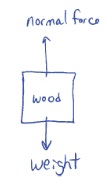A block of wood sits at rest on a tabletop. A free body diagram for the situation is shown above. State TWO action-reaction pairs of forces, in accordance with Newton’s Third Law, which involve the block of wood.
Last year, I would have branded this a difficult question, expecting correct answers from about 1/3 to 1/2 of my honors-slash-AP class. You may recall my post asking for help teaching the third law. Sure enough, a few folks chimed in. The theme of their comments: if you're gonna teach the third law properly, you've gotta establish the language of force pairs from the very beginning.
In particular, this year I piggybacked on John Burke's suggestion that every force, from day 1, be described in clear Newton's Third Law Language. Starting with the very first free body diagram I drew, I added a list of all the forces in the problem, indicating the object creating the force and the object experiencing the force. I drilled my students that they must always include such a list.
As an example, the free body diagram above would be incomplete in my class, now. Students are trained to add, "Normal force: Force of the table on the wood. Weight: Force of the earth on the wood." Sure, they squawked a bit because it took so long to write out all those words. They stopped squawking when they realized that the points they lost for laziness were never coming back, no matter how much they argued.
Then, when I finally got around to introducing the Third Law, most of the class understood quickly: to get the Third Law force pair, just switch the objects. Force of the wood on the table. Force of the wood on the earth. The process was easy, but only because everyone had long ago come to grips with the idea that, for example, weight is the force of the EARTH, not some nebulous concept like "gravity," on an object.
GCJ

No comments:
Post a Comment